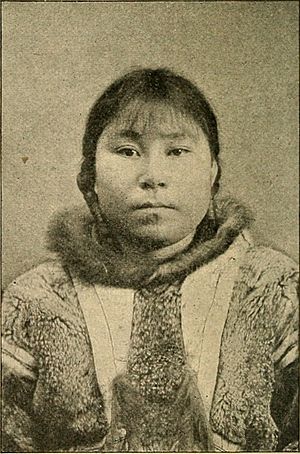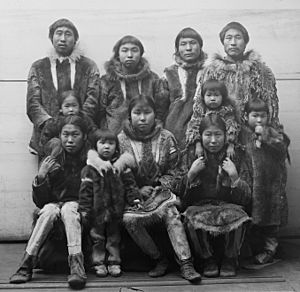Kerlungner facts for kids
Quick facts for kids
Kerlungner
|
|
|---|---|

Kerlungner, photographed by William Dinwiddie in 1894, from a 1901 publication.
|
Kerlungner (born around 1877), also known as Ker-Lung-Ner, was a young Alaska Native woman. In the 1890s, she traveled across the United States. She was part of a group called the "Eskimo Troupe," led by Miner W. Bruce.
Contents
About Kerlungner's Early Life
Kerlungner came from a group of people called the Kinugumiut or Kumu-Gu-Mut. This group lived near a place called Port Clarence, Alaska.
Touring the United States (1893-1896)
In 1894, Kerlungner was photographed with others from her community. An American researcher named William Dinwiddie took the picture. Kerlungner was one of the Alaska Native people who toured American cities. They were part of Miner Wait Bruce's "Eskimo Troupe" from 1893 to 1896.
The group was shown in ways that were not always fair. Their health and safety were sometimes at risk. The troupe included three men, four women, and three children.
Famous Appearances
The troupe performed at several big events. They were at the World's Columbian Exposition in Chicago in 1893. They also appeared at the Cotton States and International Exposition in Atlanta in 1895. Even the President of the United States, Grover Cleveland, welcomed them at the White House.
Kerlungner was often called an "Alaskan Princess." People saw her as the beautiful young woman of the group. One report in 1894 said she was "quite a pretty girl, with rosy cheeks and superlatively white teeth."
What Kerlungner Showed Audiences
Kerlungner showed off her traditional clothing. She also demonstrated how to cook traditional foods. She danced and took part in chants and drumming for the audiences. People also noticed her "small and shapely" hands and feet.
Life on Tour
Kerlungner married a fellow performer named Iser-Kyner during the tour. They had a ceremony at the Cotton States and International Exposition in 1894.
In 1896, while on the way home, Kerlungner was hurt. A part of the ship's rigging hit her head. Luckily, she recovered by the time the ship reached Unalaska. A government report from 1897 mentioned that her mother passed away that year.
In 1915, the Smithsonian Institution's Bureau of Ethnology displayed photographs of Kerlungner. These were shown at the Panama–Pacific International Exposition in San Francisco.


